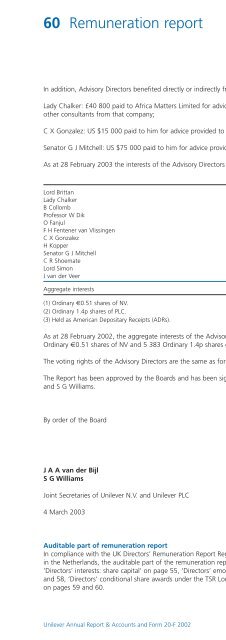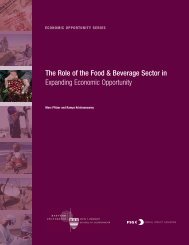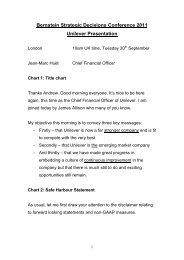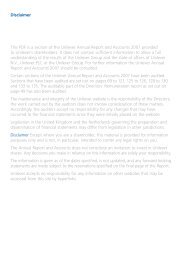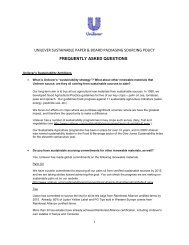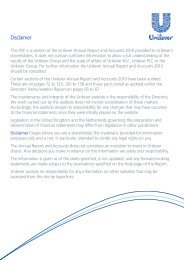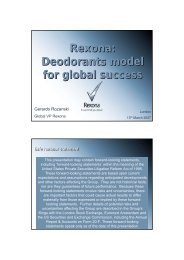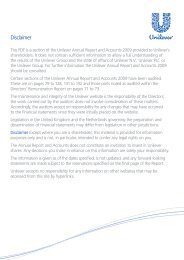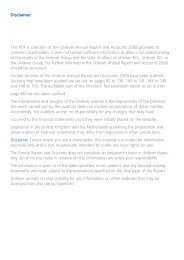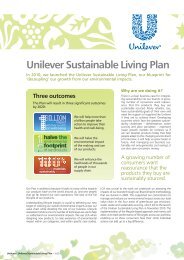Report & accounts 2002 in full - Unilever
Report & accounts 2002 in full - Unilever
Report & accounts 2002 in full - Unilever
Create successful ePaper yourself
Turn your PDF publications into a flip-book with our unique Google optimized e-Paper software.
Pensions<br />
Under <strong>Unilever</strong>´s account<strong>in</strong>g policy the expected costs of provid<strong>in</strong>g retirement pensions are charged to the profit and loss account<br />
over the periods benefit<strong>in</strong>g from the employees´ services. Variations from expected cost are similarly spread. Under US GAAP, pension<br />
costs and liabilities are calculated <strong>in</strong> accordance with SFAS 87, which requires the use of a prescribed actuarial method and a<br />
prescribed set of measurement pr<strong>in</strong>ciples.<br />
Under US GAAP an additional m<strong>in</strong>imum liability is recognised and a charge made to other comprehensive <strong>in</strong>come when the accumulated<br />
benefit obligation exceeds the fair value of plan assets to the extent that this amount is not covered by the net liability recognised <strong>in</strong> the<br />
balance sheet.<br />
With effect from 1 January <strong>2002</strong>, and for the purposes of determ<strong>in</strong><strong>in</strong>g the expected return on plan assets, <strong>Unilever</strong> changed the method of<br />
valu<strong>in</strong>g its pension plan assets from a market related value calculated by smooth<strong>in</strong>g ga<strong>in</strong>s and losses over a five year period to an actual fair<br />
value at the balance sheet date. Management believe that the actual fair value methodology provides a better representation of the f<strong>in</strong>ancial<br />
position and results of <strong>Unilever</strong>’s pension plans.<br />
The impact of this change <strong>in</strong> methodology on reported results under US GAAP is given <strong>in</strong> the table below:<br />
€ million € million<br />
2001 2000<br />
Net <strong>in</strong>come under US GAAP 1 506 1 266<br />
Change <strong>in</strong> basis of expected return on plan assets calculation 86 210<br />
Adjusted net <strong>in</strong>come under US GAAP 1 592 1 476<br />
Euro per €0.51 Euro cents per 1.4p<br />
2001 2000 2001 2000<br />
Adjusted net <strong>in</strong>come per share 1.57 1.45 23.52 21.71<br />
Adjusted diluted net <strong>in</strong>come per share 1.52 1.41 22.89 21.18<br />
As required under US APB 20 for a change <strong>in</strong> account<strong>in</strong>g policy, a cumulative effect adjustment has been calculated to record the impact of<br />
the change as if the fair value methodology had been the account<strong>in</strong>g policy from the <strong>in</strong>itial adoption of SFAS 87 by <strong>Unilever</strong>. The cumulative<br />
effect adjustment net of tax is €522 million <strong>in</strong> <strong>2002</strong>.<br />
Investments<br />
<strong>Unilever</strong> <strong>accounts</strong> for current <strong>in</strong>vestments, which are liquid funds temporarily <strong>in</strong>vested, at their market value, which is consistent with<br />
UK GAAP.<br />
<strong>Unilever</strong> <strong>accounts</strong> for changes <strong>in</strong> the market value of current <strong>in</strong>vestments as <strong>in</strong>terest receivable <strong>in</strong> the profit and loss account for the year.<br />
Under US GAAP, such current asset <strong>in</strong>vestments are classified as ‘available for sale securities’ and changes <strong>in</strong> market values, which represent<br />
unrealised ga<strong>in</strong>s or losses, are excluded from earn<strong>in</strong>gs and taken to stockholders’ equity. Unrealised ga<strong>in</strong>s and losses aris<strong>in</strong>g from changes <strong>in</strong><br />
the market values of securities available for sale are not material.<br />
<strong>Unilever</strong> <strong>accounts</strong> for fixed <strong>in</strong>vestments other than <strong>in</strong> jo<strong>in</strong>t ventures and associates at cost less any amounts written off to reflect a<br />
permanent impairment. Under US GAAP such <strong>in</strong>vestments are held at fair value. The difference is not material.<br />
Dividends<br />
The proposed f<strong>in</strong>al ord<strong>in</strong>ary dividends are provided for <strong>in</strong> the <strong>Unilever</strong> <strong>accounts</strong> <strong>in</strong> the f<strong>in</strong>ancial year to which they relate. Under US GAAP<br />
such dividends are not provided for until they become irrevocable.<br />
Deferred taxation<br />
<strong>Unilever</strong> has restated its deferred tax charge for the year ended 31 December 2000, and its deferred tax balances as at 31 December 2001<br />
to comply with the new UK account<strong>in</strong>g standard FRS 19, as described <strong>in</strong> note 18 on page 94. Under FRS 19, deferred tax is not recognised<br />
on fair value adjustments made to assets acquired; under US GAAP, deferred tax is recorded on all fair value adjustments. Also, as described<br />
on page 94, FRS 19 has changed the treatment of deferred tax on tax-deductible goodwill previously written off to reserves. Such goodwill<br />
is re<strong>in</strong>stated, net of amortisation, under US GAAP, and the tax effect of such restatement has been adjusted accord<strong>in</strong>gly.<br />
<strong>Unilever</strong> Annual <strong>Report</strong> & Accounts and Form 20-F <strong>2002</strong><br />
Additional <strong>in</strong>formation for US <strong>in</strong>vestors 121<br />
<strong>Unilever</strong> Group<br />
F<strong>in</strong>ancial Statements


